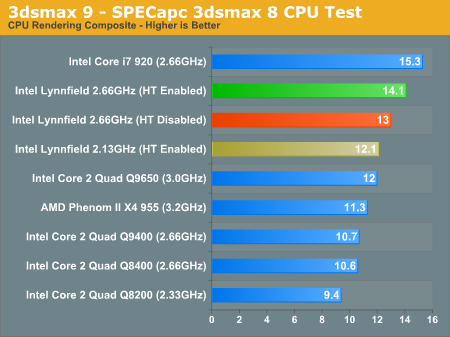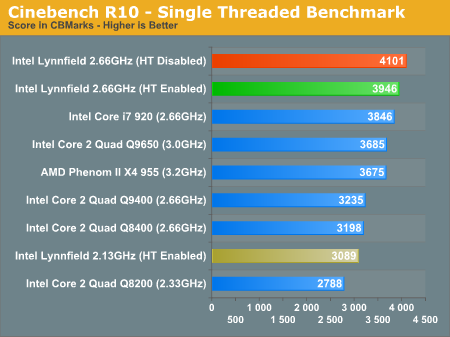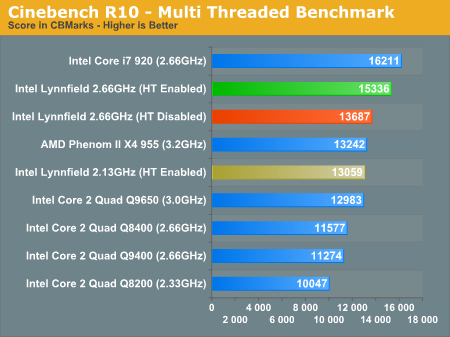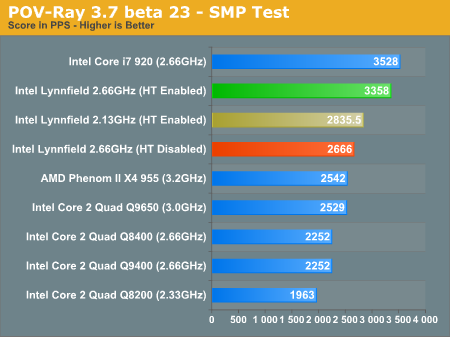The Lynnfield Preview: Rumblings of Revenge
by Anand Lal Shimpi on May 29, 2009 1:00 PM EST- Posted in
- CPUs
3dsmax 9 - SPECapc 3dsmax CPU Rendering Test
Today's desktop processors are more than fast enough to do professional level 3D rendering at home. To look at performance under 3dsmax we ran the SPECapc 3dsmax 8 benchmark (only the CPU rendering tests) under 3dsmax 9 SP1. The results reported are the rendering composite scores:

There are three key takeaway points here.
1) Hyper Threading allows the i7-920 to outperform the entry level Lynnfield by nearly 18%.
2) With HT disabled, the $196 Lynnfield is faster than the $316 Core 2 Quad Q9650. It's a true replacement for Penryn in the lineup.
3) Intel could release an even slower Lynnfield and, by enabling HT, offer a chip faster than all other Penryn and Phenom II based processors in the market.
Cinebench R10
Created by the Cinema 4D folks we have Cinebench, a popular 3D rendering benchmark that gives us both single and multi-threaded 3D rendering results.

The single threaded Cinebench test shows us just how powerful the Nehalem core is. Remember, we're looking at single-core performance here.
Without an aggressive turbo mode, the 2.66GHz Lynnfield sample is faster than a 3.0GHz Penryn. Even at 2.13GHz Lynnfield is able to perform like a 2.5GHz Penryn. This is a very flexible core.
These results also give you an indication of exactly how strong the dual-core Nehalem derivatives will be in notebooks late this year and into 2010.

Crank up the thread count and feel the frustration brew. The entry level Lynnfield won't have Hyper Threading enabled, and thus it'll only outperform the Phenom II 955 by 3.4%. Had Intel enabled the HT switch, Lynnfield would not only be 16% faster than AMD's best but it would also be only 5% slower than the i7-920.
POV-Ray 3.73 beta 23 Ray Tracing Performance
POV-Ray is a popular, open-source raytracing application that also doubles as a great tool to measure CPU floating point performance.
I ran the SMP benchmark in beta 23 of POV-Ray 3.73. The numbers reported are the final score in pixels per second.

We see a similar story in POV-Ray.










95 Comments
View All Comments
rmlarsen - Friday, May 29, 2009 - link
This is my concern too. While I suppose I should give the Westmere IGP the benefit of the doubt, I do not have high hopes that it will be anywhere near the performance of the ATI and NVIDIA IGPs we see today.And Intel is of course pulling the same stunt with the new Atom chipset.
ssj4Gogeta - Friday, May 29, 2009 - link
I really hope they have a decent graphics core for Westmere. Otherwise the consumers are going to be really annoyed. I read at the INQ that it's going to be much better than current Intel IGP's. Let's hope that's true.Maybe they want to eventually replace it with a couple of Larrabee cores in the future.
TA152H - Friday, May 29, 2009 - link
I'm reading this, and I'm really surprised at how slow the Lynnfield is compared to the Core i7. Yet, Anand keeps saying how good it is. What am I missing? It's the same processor, but with modified memory access, and it gets run over by the i7 by up to 5% on many benchmarks.This sounds like a brain-damaged chip that should not be made. Sure, they can do turbo-mode better, but they can do that on the i7 as well, and may very well do that with the next revision. It seems the trade-offs have a very significant impact on performance.
They should name it the Celeron - which also is performs pretty well, but is brain-damaged enough it's not really competitive with Intel's really good CPUs.
It's still a really good CPU, outside of the context that the i7 is much better. But, if the prices don't overlap, it's still more than good enough to beat anything AMD puts out, and even the Penryn. Still, I'm really surprised at the low performance. I figured it would be close, because dual channel should have better latency than three channel, and the throughput rate wouldn't make so much of a difference. Oh well. At least I know not to wait.
Great article, Anand. I do not really agree with your assessment of it, although I agree it's still a very attractive processor for many, it was very informative and helps me decide what and when to buy now. Thanks!
mesiah - Saturday, May 30, 2009 - link
I think you are overlooking one important factor here. One reason Anand is so excited about the numbers that the lynnfield posted is because it is a crippled pre-production proccessor. With all of the limitations put on this sample chip it still performs admirably, and the actual production samples almost always outperform these early sample chips.TemjinGold - Friday, May 29, 2009 - link
You do realize Lynnfield is meant to be the MAINSTREAM part while Bloomfield is the ENTHUSIAST part, right? It was never meant to beat the i7 just as nVidia's GTX260 Core 216 isn't meant to beat the GTX280. That's why it's so much cheaper. By your logic, AMD's entire lineup "shouldn't be made" as all of their chips get creamed by the i7.TA152H - Friday, May 29, 2009 - link
If Intel were making the Phenom II, I would say there's no reason for the chips at all. They are expensive and slow. But, AMD really has no choice, since they don't have a better design available.Your logic is weak. i7 is a LINE of processors, with very expensive ones, and ones that are not so expensive. It's much broader than the GTX280.
The reality is, it's not that much more expensive for Intel to make the i7. It's more of a marketing segmentation situation, just like they compromise lower end processors now. In this case, the loss of performance is really dramatic, and it's not like they're able to use chips they wouldn't be able to use otherwise, by disabling cache, or that the Lynnfield is going to be a lot smaller.
We'll see when Anand gets the actual size, but I'd be shocked if you see a substantial difference in size. Probably the Lynnfield will be bigger, since some logic is on the processor now.
I don't think it's a great tradeoff to lose so much performance, for the limited cost savings. I'd rather have seen them bring the i7 at lower clock speeds down to better prices, instead of artificially inflating the x58 price.
Anand Lal Shimpi - Saturday, May 30, 2009 - link
You are correct, Lynnfield shouldn't be any smaller than Bloomfield (current i7). Remember that this is not only an early chip but it's on a mostly untuned motherboard. I've heard up to a 10% increase in performance for final shipping platforms. That may be more aggressive than I'd say but I think Jarred is on point here; I'd be surprised if we saw an appreciable difference between the i7-920 and the 2.66GHz Lynnfield in apps that spawn 4 or fewer CPU intensive threads.It's totally an artificial separation from a silicon standpoint. Intel could just as easily make everything a LGA-1366 processor and forget entirely about 1156. I'm assuming that 1366 boards would inherently be a bit more expensive as routing the QPI link requires a bit more effort than DMI. The main thing is that 1366 does not provide for on-die PCIe, which is necessary given the direction that Intel is going with mainstream graphics.
I think in the long run 1366 will be reserved for very thread heavy work; the Skulltrail successor will only use 1366 sockets. Enthusiast overclockers may also flock to 1366 but I believe the majority of the market will be served just fine by 1156.
Take care,
Anand
red77star - Wednesday, September 9, 2009 - link
I think you're wrong. The only reason Intel released LGA1156 was to 'kill' AMD. It seems to me that Intel doesn't want AMD to be able to compete. Honestly, LGA-1156 has no single value in it. There will never be 6-core CPU for this platform therefore it's absolutely 'future' useless. I own LGA1366 and i realized that i did good purchase. i920 is too good for $279 that Intel wants to kill it. i920 can be overclocked over 1000Mhz, probably not reachable for any of LGA1156 variant. We are talking about 1000Mhz overclock on air cooler and even higher. C0 revision will run 3.8Ghz fine, and D0 over 4.0Ghz meaning it will outperform anything out there. I don't think LGA1366 is only server reserved, wait for 1H 2010 and 6 core release. As soon as AMD pushes 6-core AM3 CPU for the price of newest crippled i7, existence of LGA1156 will lose any point.In my book Intel should had released cheaper version of x58 with less features (like less SATA ports, single PCIEx16 etc, dual channel memory), and what they did with LGA1156 CPUs, they could do same in LGA1366 package (by crippling i920) so everything is compatible across the platform and of course kill LGA775.
Now we have LGA775, LGA1156, LGA1366 - it's called bullshit.
esgreat - Saturday, May 30, 2009 - link
If you want performance, definitely i7 is the way to go...and yes, it does look like a purposeful marketing segmentation.It also boils down to price, not really to the end users but the bill of materials (BOM) cost to the manufacturers. A one chip 'chipset' solution will bring about significantly fewer components (capacitors, resistors), and also enable smaller form factors
This would also mean that as the boards are released, the prices have much more room to drop compared to x58. And the fact that this is the volume mainstream part, economies of scale would ensure significant drops in prices.
This would make great platforms for the majority of the computers sold by Dell, HP, etc (did I mention that P55 is a 'mainstream' chipset?). Large boards like the X58 isn't suitable for all applications. Imagine trying to stuff a huge X58 motherboard into a mini-chassis business desktop.
And hey, the fact that you're an enthusiast and performance-conscious user, all your logical explanations concluded choosing the 'performance' platform, i7...exactly how Intel wanted you to do.
Essentially you choose the performance you want depending on how much you have in your wallet. There's a potential $100-$200 cost savings for Lynnfield which I don't think is 'little'.
The only question I ask is why you think Lynnfield is not going to be smaller than i7? I thought Anand showed photographs comparing their sizes.
MrRuckus - Friday, May 29, 2009 - link
"and it gets run over by the i7 by up to 5% on many benchmarks."Did you really say that? So if 5% is such a large amount, what would you consider to be close??
Running on an intentionally crippled memory controller and only being 5% away from an i7, I would say thats outstanding.